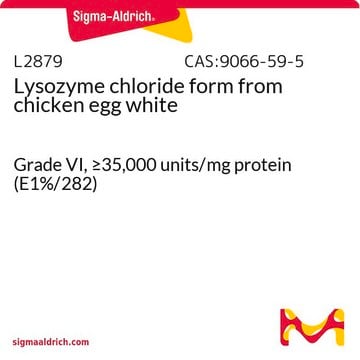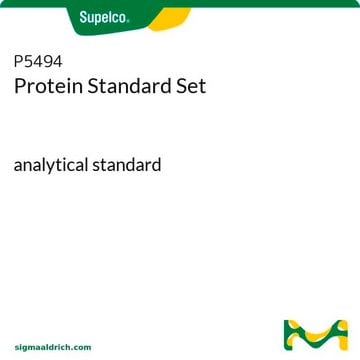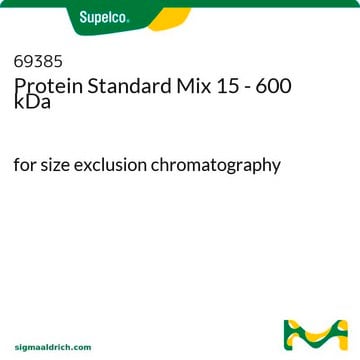34046
Lysozyme from chicken egg white
VETRANAL®, analytical standard
Synonym(s):
Mucopeptide N-acetylmuramoylhydrolase, Muramidase
Sign Into View Organizational & Contract Pricing
All Photos(1)
About This Item
CAS Number:
EC Number:
MDL number:
UNSPSC Code:
41116107
NACRES:
NA.24
Recommended Products
grade
analytical standard
Quality Level
product line
VETRANAL®
specific activity
8000-120000 U/mg
shelf life
limited shelf life, expiry date on the label
mol wt
single-chain 14.3 kDa
Mr ~14000
analyte chemical class(es)
amino acids, peptides, proteins
technique(s)
HPLC: suitable
application(s)
food and beverages
format
neat
storage temp.
2-8°C
Looking for similar products? Visit Product Comparison Guide
General description
Lysozyme from chicken egg white, is a protein that can show broad spectrum of antibacterial activity against gram positive and gram negative bacteria. Its antimicrobial activity can be enhanced by pretreatment of the target microbial cells with chelating agents like ethylenediaminetetraacetic acid (EDTA).
Lysozyme from chicken egg white, is a protein that can show broad spectrum of antibacterial activity against gram positive and gram negative bacteria. Its antimicrobial activity can be enhanced by pretreatment of the target microbial cells with chelating agents like ethylenediaminetetraacetic acid (EDTA).
Application
Lysozyme from chicken egg white may be used as an analytical reference standard for the determination of the analyte in:
- Hard and pasta filata cheeses using reversed-phase high performance liquid chromatography with diode array and fluorimetric detection [(RP-HPLC-DAD) and (RP-HPLC-FLD)].
- Food samples using high-performance liquid chromatography (HPLC) and enzyme-linked immunosorbent assay (ELISA).
Enzyme breaks down the cell walls of bacteria; used to prepare spheroplasts.
Biochem/physiol Actions
Lysozyme hydrolyzes β(1→4) linkages between N-acetylmuramic acid and N-acetyl-D-glucosamine residues in peptidoglycan and between N-acetyl-D-glucosamine residues in chitodextrin. Gram-positive cells are quite susceptible to this hydrolysis as their cell walls have a high proportion of peptidoglycan. Gram-negative bacteria are less susceptible due to the presence of an outer membrane and a lower proportion of peptidoglycan. However, these cells may be hydrolyzed in the presence of EDTA that chelates metal ions in the outer bacterial membrane.
The enzyme is active over a broad pH range (6.0 to 9.0). At pH 6.2, maximal activity is observed over a wider range of ionic strengths (0.02 to 0.100 M) than at pH 9.2 (0.01 to 0.06 M).
The enzyme is active over a broad pH range (6.0 to 9.0). At pH 6.2, maximal activity is observed over a wider range of ionic strengths (0.02 to 0.100 M) than at pH 9.2 (0.01 to 0.06 M).
Unit Definition
1 unit corresponds to the amount of enzyme which decreases the absorbance at 450 nm by 0.001 per minute at pH 7.0 and 25 deg C.
Legal Information
VETRANAL is a registered trademark of Merck KGaA, Darmstadt, Germany
Signal Word
Danger
Hazard Statements
Precautionary Statements
Hazard Classifications
Resp. Sens. 1
Storage Class Code
11 - Combustible Solids
WGK
WGK 3
Flash Point(F)
Not applicable
Flash Point(C)
Not applicable
Personal Protective Equipment
dust mask type N95 (US), Eyeshields, Gloves
Choose from one of the most recent versions:
Already Own This Product?
Find documentation for the products that you have recently purchased in the Document Library.
Customers Also Viewed
Detection of hen?s egg white lysozyme in food: Comparison between a sensitive HPLC and a commercial ELISA method.
Kerkaert B, et al.
Food Chemistry, 120(2), 580-584 (2010)
"Identification and isolation of a bactericidal domain in chicken egg white lysozyme"
Pellegrini.A, et al
Journal of Applied Microbiology, 82(03), 372-378 (1997)
"Antimicrobial peptides released by enzymatic hydrolysis of hen egg white lysozyme"
Mine Y, et al.
Journal of Agricultural and Food Chemistry, 52(05), 1088-1094 (2004)
Identification and isolation of a bactericidal domain in chicken egg white lysozyme
Pellegrini.A, et al.
Journal of Applied Microbiology, 82, 372-378 (1997)
Development of an RP-HPLC method for the simultaneous determination of benzoic acid, sorbic acid, natamycin and lysozyme in hard and pasta filata cheeses.
Guarino C, et al.
Food Chemistry, 127(3), 1294-1299 (2011)
Our team of scientists has experience in all areas of research including Life Science, Material Science, Chemical Synthesis, Chromatography, Analytical and many others.
Contact Technical Service







